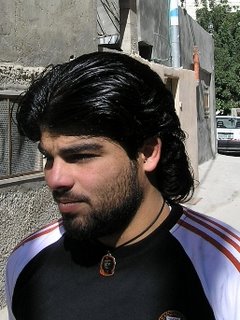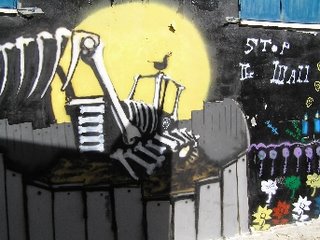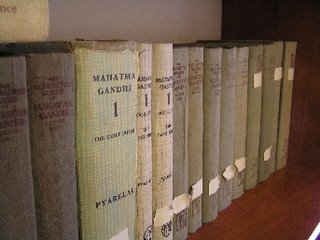Thursday, November 03, 2005
Guevara and Gandhi
Note: Our homestays tonight with Beit Sahour families were arranged by Alternative Tourism Group.
 The first thing you notice about Jihad is that he looks just like his necklace. His hair is full and thick, his beard scruffy, his face an intense gaze. “They call me Che,” he tells us, as he fingers the Guevara medallion around his neck. “Che” takes us on a tour of Bethlehem’s Dheisheh Refugee Camp, one square kilometer which 11,000 Palestinians call home. Refugees and their descendants from the West Jerusalem corridor, Dheisheh’s residents (like their counterparts in the Territories and throughout the Middle East) were dispossessed by the establishment of Israel, alternately ignored or manipulated by the Arab world, overlooked by the Palestinian Authority, and largely dismissed by the international community. Their narrative, as “Che” shared with us, is strong and hard to swallow. For Palestinians, the dispossession of 1948 is central to their identity, and any effort to understand them must hear such voices.
The first thing you notice about Jihad is that he looks just like his necklace. His hair is full and thick, his beard scruffy, his face an intense gaze. “They call me Che,” he tells us, as he fingers the Guevara medallion around his neck. “Che” takes us on a tour of Bethlehem’s Dheisheh Refugee Camp, one square kilometer which 11,000 Palestinians call home. Refugees and their descendants from the West Jerusalem corridor, Dheisheh’s residents (like their counterparts in the Territories and throughout the Middle East) were dispossessed by the establishment of Israel, alternately ignored or manipulated by the Arab world, overlooked by the Palestinian Authority, and largely dismissed by the international community. Their narrative, as “Che” shared with us, is strong and hard to swallow. For Palestinians, the dispossession of 1948 is central to their identity, and any effort to understand them must hear such voices.  Dheisheh’s Ibdaa Center, our host, works overtime to make sure that the world has the chance to listen. They have preserved pictures of their community from 1948 on, and the entrance to the Center is framed by the revolving cage which was the camp’s only entrance/exit from 1985 to 1995, the Israeli army controlling their coming and going and surrounding them with a tall fence. “Che” himself had little time for communal self-critique (e.g. defining all Palestinian resistance as a purely defensive act). Unfortunately, among Palestinians and Israelis, as among Americans or Iraqis, such humility is all-too absent.
Dheisheh’s Ibdaa Center, our host, works overtime to make sure that the world has the chance to listen. They have preserved pictures of their community from 1948 on, and the entrance to the Center is framed by the revolving cage which was the camp’s only entrance/exit from 1985 to 1995, the Israeli army controlling their coming and going and surrounding them with a tall fence. “Che” himself had little time for communal self-critique (e.g. defining all Palestinian resistance as a purely defensive act). Unfortunately, among Palestinians and Israelis, as among Americans or Iraqis, such humility is all-too absent.
 A few miles away, the offices of Holy Land Trust are lined with The Complete Works of Mahatma Gandhi. Hosam Jubran, one of the leaders of this Muslim-Christian organization, outlined the various programs of HLT. Primary among them is their nonviolence awareness and training. Hosam spends much of his time traveling the West Bank, educating young people about the religious and national histories of non-violent resistance which Palestinian Christians and Muslims share. Nationally, the image of non-violence is that of passivity, acquiescence. But when Hosam explains that Palestinians have always had a history of non-violent resistance – tax revolts, worker strikes, etc. – opinions begin to shift. “The success of violent resistance as a strategy is a valid debate,” he tells us. “But there is no question about the success of non-violent resistance. Our goal is not simply to end the Occupation, but to build civil society afterwards.” In other words, a culture of non-violence spells a brighter future. Hosam sees non-violent resistance growing, highlighting the active creativity of towns like Bil’in and Budros. “Our work now is to connect the dots. We are one to two years away from a serious national non-violent movement.”
A few miles away, the offices of Holy Land Trust are lined with The Complete Works of Mahatma Gandhi. Hosam Jubran, one of the leaders of this Muslim-Christian organization, outlined the various programs of HLT. Primary among them is their nonviolence awareness and training. Hosam spends much of his time traveling the West Bank, educating young people about the religious and national histories of non-violent resistance which Palestinian Christians and Muslims share. Nationally, the image of non-violence is that of passivity, acquiescence. But when Hosam explains that Palestinians have always had a history of non-violent resistance – tax revolts, worker strikes, etc. – opinions begin to shift. “The success of violent resistance as a strategy is a valid debate,” he tells us. “But there is no question about the success of non-violent resistance. Our goal is not simply to end the Occupation, but to build civil society afterwards.” In other words, a culture of non-violence spells a brighter future. Hosam sees non-violent resistance growing, highlighting the active creativity of towns like Bil’in and Budros. “Our work now is to connect the dots. We are one to two years away from a serious national non-violent movement.”
 HLT seems to be picking up the mantle from an earlier generation of leaders like Zoughbi Zoughbi. Now a member of the Bethlehem city council, Zoughbi has been a long-time advocate for non-violence. He speaks to us from the office of the Wi’am Palestinian Conflict Resolution Center, the rest of the building bustling with young people role-playing and debriefing simulated conflicts. “We don’t want to bring Israel to her knees. We want to bring Israel to her senses.” Seeing the Wall around Bethlehem now complete, he certainly seems more optimistic than the situation warrants. But his energy and that of HLT leave me more hopeful than ever.
HLT seems to be picking up the mantle from an earlier generation of leaders like Zoughbi Zoughbi. Now a member of the Bethlehem city council, Zoughbi has been a long-time advocate for non-violence. He speaks to us from the office of the Wi’am Palestinian Conflict Resolution Center, the rest of the building bustling with young people role-playing and debriefing simulated conflicts. “We don’t want to bring Israel to her knees. We want to bring Israel to her senses.” Seeing the Wall around Bethlehem now complete, he certainly seems more optimistic than the situation warrants. But his energy and that of HLT leave me more hopeful than ever.
 The first thing you notice about Jihad is that he looks just like his necklace. His hair is full and thick, his beard scruffy, his face an intense gaze. “They call me Che,” he tells us, as he fingers the Guevara medallion around his neck. “Che” takes us on a tour of Bethlehem’s Dheisheh Refugee Camp, one square kilometer which 11,000 Palestinians call home. Refugees and their descendants from the West Jerusalem corridor, Dheisheh’s residents (like their counterparts in the Territories and throughout the Middle East) were dispossessed by the establishment of Israel, alternately ignored or manipulated by the Arab world, overlooked by the Palestinian Authority, and largely dismissed by the international community. Their narrative, as “Che” shared with us, is strong and hard to swallow. For Palestinians, the dispossession of 1948 is central to their identity, and any effort to understand them must hear such voices.
The first thing you notice about Jihad is that he looks just like his necklace. His hair is full and thick, his beard scruffy, his face an intense gaze. “They call me Che,” he tells us, as he fingers the Guevara medallion around his neck. “Che” takes us on a tour of Bethlehem’s Dheisheh Refugee Camp, one square kilometer which 11,000 Palestinians call home. Refugees and their descendants from the West Jerusalem corridor, Dheisheh’s residents (like their counterparts in the Territories and throughout the Middle East) were dispossessed by the establishment of Israel, alternately ignored or manipulated by the Arab world, overlooked by the Palestinian Authority, and largely dismissed by the international community. Their narrative, as “Che” shared with us, is strong and hard to swallow. For Palestinians, the dispossession of 1948 is central to their identity, and any effort to understand them must hear such voices.  Dheisheh’s Ibdaa Center, our host, works overtime to make sure that the world has the chance to listen. They have preserved pictures of their community from 1948 on, and the entrance to the Center is framed by the revolving cage which was the camp’s only entrance/exit from 1985 to 1995, the Israeli army controlling their coming and going and surrounding them with a tall fence. “Che” himself had little time for communal self-critique (e.g. defining all Palestinian resistance as a purely defensive act). Unfortunately, among Palestinians and Israelis, as among Americans or Iraqis, such humility is all-too absent.
Dheisheh’s Ibdaa Center, our host, works overtime to make sure that the world has the chance to listen. They have preserved pictures of their community from 1948 on, and the entrance to the Center is framed by the revolving cage which was the camp’s only entrance/exit from 1985 to 1995, the Israeli army controlling their coming and going and surrounding them with a tall fence. “Che” himself had little time for communal self-critique (e.g. defining all Palestinian resistance as a purely defensive act). Unfortunately, among Palestinians and Israelis, as among Americans or Iraqis, such humility is all-too absent. A few miles away, the offices of Holy Land Trust are lined with The Complete Works of Mahatma Gandhi. Hosam Jubran, one of the leaders of this Muslim-Christian organization, outlined the various programs of HLT. Primary among them is their nonviolence awareness and training. Hosam spends much of his time traveling the West Bank, educating young people about the religious and national histories of non-violent resistance which Palestinian Christians and Muslims share. Nationally, the image of non-violence is that of passivity, acquiescence. But when Hosam explains that Palestinians have always had a history of non-violent resistance – tax revolts, worker strikes, etc. – opinions begin to shift. “The success of violent resistance as a strategy is a valid debate,” he tells us. “But there is no question about the success of non-violent resistance. Our goal is not simply to end the Occupation, but to build civil society afterwards.” In other words, a culture of non-violence spells a brighter future. Hosam sees non-violent resistance growing, highlighting the active creativity of towns like Bil’in and Budros. “Our work now is to connect the dots. We are one to two years away from a serious national non-violent movement.”
A few miles away, the offices of Holy Land Trust are lined with The Complete Works of Mahatma Gandhi. Hosam Jubran, one of the leaders of this Muslim-Christian organization, outlined the various programs of HLT. Primary among them is their nonviolence awareness and training. Hosam spends much of his time traveling the West Bank, educating young people about the religious and national histories of non-violent resistance which Palestinian Christians and Muslims share. Nationally, the image of non-violence is that of passivity, acquiescence. But when Hosam explains that Palestinians have always had a history of non-violent resistance – tax revolts, worker strikes, etc. – opinions begin to shift. “The success of violent resistance as a strategy is a valid debate,” he tells us. “But there is no question about the success of non-violent resistance. Our goal is not simply to end the Occupation, but to build civil society afterwards.” In other words, a culture of non-violence spells a brighter future. Hosam sees non-violent resistance growing, highlighting the active creativity of towns like Bil’in and Budros. “Our work now is to connect the dots. We are one to two years away from a serious national non-violent movement.” HLT seems to be picking up the mantle from an earlier generation of leaders like Zoughbi Zoughbi. Now a member of the Bethlehem city council, Zoughbi has been a long-time advocate for non-violence. He speaks to us from the office of the Wi’am Palestinian Conflict Resolution Center, the rest of the building bustling with young people role-playing and debriefing simulated conflicts. “We don’t want to bring Israel to her knees. We want to bring Israel to her senses.” Seeing the Wall around Bethlehem now complete, he certainly seems more optimistic than the situation warrants. But his energy and that of HLT leave me more hopeful than ever.
HLT seems to be picking up the mantle from an earlier generation of leaders like Zoughbi Zoughbi. Now a member of the Bethlehem city council, Zoughbi has been a long-time advocate for non-violence. He speaks to us from the office of the Wi’am Palestinian Conflict Resolution Center, the rest of the building bustling with young people role-playing and debriefing simulated conflicts. “We don’t want to bring Israel to her knees. We want to bring Israel to her senses.” Seeing the Wall around Bethlehem now complete, he certainly seems more optimistic than the situation warrants. But his energy and that of HLT leave me more hopeful than ever. Marthame Sanders lived in the Palestinian Christian village of Zababdeh with his wife Elizabeth from 2000 to 2003.
He is a Presbyterian minister and president of Salt Films.
Marthame Sanders lived in the Palestinian Christian village of Zababdeh with his wife Elizabeth from 2000 to 2003.
He is a Presbyterian minister and president of Salt Films.